
Bronze sculptures and land art represent two distinct approaches to integrating art with the environment, each with unique characteristics and impacts. Bronze sculptures, often cast from durable metal, are permanent installations that can withstand harsh weather conditions. However, their production involves mining and metallurgy, which may raise environmental concerns. In contrast, land art is typically created using natural materials like soil, rocks, and vegetation, emphasizing harmony with the surrounding landscape.
One key difference lies in their interaction with nature. Bronze sculptures, though long-lasting, often remain static, requiring minimal adaptation to their surroundings. Land art, on the other hand, evolves over time, sometimes even decaying naturally, reinforcing its connection to the environment. Artists like Andy Goldsworthy exemplify this ephemeral quality, crafting pieces that change with seasons.
Another aspect is scale and visibility. Bronze sculptures are usually freestanding, designed to stand out as focal points, while land art blends seamlessly into its setting, sometimes requiring exploration to be fully appreciated. The choice between these forms depends on the artist’s intent—whether to impose human creativity on nature or to collaborate with it.
Ultimately, both bronze sculptures and land art contribute to environmental aesthetics but in fundamentally different ways. Bronze offers permanence and craftsmanship, while land art celebrates impermanence and ecological symbiosis. The debate between them highlights broader questions about art's role in our relationship with the natural world.

